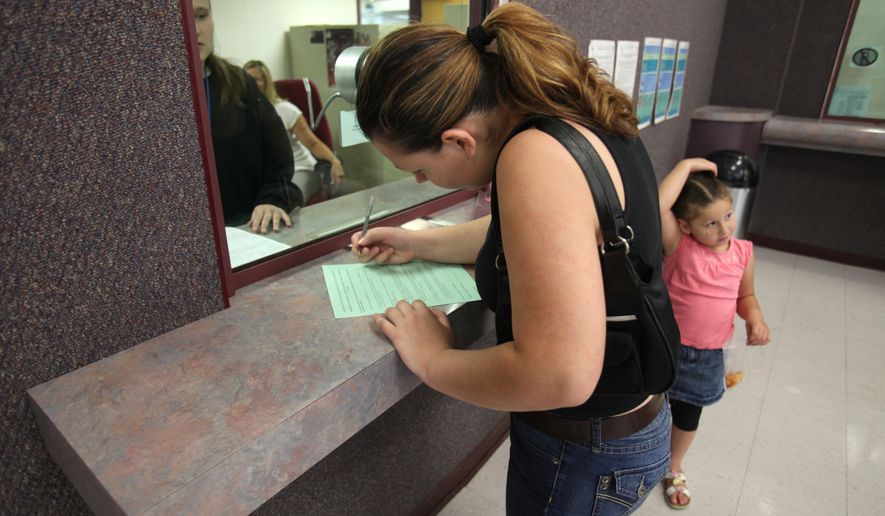Immigrants are supposed to be beneficial to the U.S. — so much so that federal law requires them to prove they won’t end up on the public dole if they are legally admitted.
But it’s a stricture honored more in the breach than in compliance, according to statistics obtained by the Federation for American Immigration Reform, which found that of the millions of legal immigrants living in the U.S. and collecting welfare or other public benefits, only a single person was kicked out of the country over the last three years for becoming a public burden.
That seems to fly in the face of federal policies that, dating back to the very first broad immigration law in the 1880s, have demanded that immigrants prove they will be able to support themselves.
New immigrants can be denied if they can’t show their financial means, and those already in the country can be deported if they fail to live up to the bargain — but that hardly ever happens, according to FAIR’s data.
The group had asked the Executive Office for Immigration Review, which hears the cases, for data on five countries: Mexico, Guatemala, Honduras, Cuba and Colombia. EOIR said it found just three cases brought between 2013 and 2015, all of them against Mexicans, and only one of those charges was sustained.
EOIR said it didn’t have data for all nationalities.
QUIZ: How well do you know the Star Wars universe?
No enforcement means more impoverished immigrants willing to test their chances, said Ian Smith, the FAIR investigator who obtained the data.
“Like all removal grounds, they’re supposed to deter that behavior, and it’s there to make sure that [those] people come into this country are at least somewhat desirable,” he said. “It was supposed to be a filtration mechanism. It’s like anything. If you don’t enforce it, the deterrence element gets turned off.”
More than half of immigrant-led households use at least one welfare program, according to research by the Center for Immigration Studies. By comparison, 30 percent of households led by native-born U.S. citizens take welfare.
Immigrants from Mexico and Central America have the highest rate, with nearly three-quarters using at least one program. The Caribbean is second, with a 51 percent use rate.
The center said that’s not surprising given that welfare is inversely related to education, meaning the less educated someone is, the more likely he or she will be poor and will take welfare. Central American and Mexican immigrants are overwhelmingly less educated, according to the center’s findings.
But making charges stick against immigrants on the dole is exceedingly difficult, analysts say.
PHOTOS: Best undercover pocket pistols
While the law doesn’t define “public charge,” court cases and guidance the Clinton administration issued in the late 1990s has restricted when agents can pursue cases.
According to those requirements, many welfare programs don’t even count against immigrants, and even when they do, states or federal agencies must have tried to get the immigrant to repay the money, a judge has to have sided with the government’s case, and the immigrant must have refused to comply in order for a public charge case to stick. The violation also must have occurred in the first several years after an immigrant was admitted.
“Collectively, the various sources addressing the meaning of public charge suggest that an alien’s receipt of public benefits, per se, is unlikely to result in the alien being deemed removable on public charge grounds,” the Congressional Research Service concluded in a report earlier this year.
Mr. Smith, the FAIR investigator who obtained the new data from the government, said it’s time to loosen the requirements.
“More programs, not just cash programs, should be made out of bounds for immigrants when it comes to public charge removability. America’s bountiful welfare system is a major magnet for unskilled foreigners to come here,” he said.
A top EOIR official told FAIR that the government’s rare use of public charge cases is likely due to the difficulty of making the charges stick. He said when federal officials decide someone needs to go, they go after some other breach that’s easier to prove.
The EOIR declined to comment to The Washington Times, saying the agency doesn’t interpret its data, nor will it discuss individual cases.
U.S. Immigration and Customs Enforcement, the agency responsible for bringing the cases in the first place, signaled that it’s focused on more serious cases such as risks to national security.
“ICE is committed to focusing on smart, effective immigration enforcement and makes custody determinations on a case-by-case basis, prioritizing serious criminal offenders and other individuals who pose a risk to national security or public safety,” said Jennifer Elzea, an ICE spokeswoman.
• Stephen Dinan can be reached at sdinan@washingtontimes.com.




Please read our comment policy before commenting.